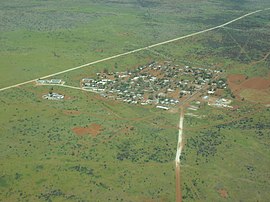Amata, Australia
|
Amata South Australia |
|||||||||
|---|---|---|---|---|---|---|---|---|---|
 |
|||||||||
| Coordinates | 26°09′S 131°08′E / 26.150°S 131.133°ECoordinates: 26°09′S 131°08′E / 26.150°S 131.133°E | ||||||||
| Population | 479 (2011 census) | ||||||||
| Established | 1961 | ||||||||
| Postcode(s) | 5710 | ||||||||
| Elevation | 690 m (2,264 ft) | ||||||||
| Location | 1,407 km (874 mi) North West of Adelaide via |
||||||||
| LGA(s) | Anangu Pitjantjatjara Yankunytjatjara | ||||||||
| State electorate(s) | Giles | ||||||||
| Federal Division(s) | Grey | ||||||||
|
|||||||||
Amata is an Aboriginal community in the Anangu Pitjantjatjara Yankunytjatjara Lands in South Australia, comprising one of the six main communities on "The Lands" (the others being Ernabella/Pukatja, Fregon/Kaltjiti, Indulkana, Mimili and Pipalyatjara).
Amata is situated to the west of the Ernabella/Pukatja community. Amata sits approximately 250 kilometres west of the Stuart Highway and 40 kilometres south of the Northern Territory/South Australia border at the base of the Musgrave Ranges.
Based upon the climate records of the nearest weather station at Marla Police Station, Amata experiences summer maximum temperatures of an average of 37.1 degrees Celsius in January and a winter maximum average temperature of 19.7 degrees Celsius in June. Overnight lows range from a mean minimum temperature of 21.8 degrees in January to 5.0 degrees in June.
Annual rainfall averages 222.6 millimetres.
Amata's population is 479. It is situated outside of the traditional territory of the Anangu people, some of whom nonetheless live there.
Australian Bureau of Statistics research indicated in 2003 that the 2001 census data showed that Amata had one of the State's highest proportions of Aboriginal residents (89%) and, in all of South Australia, Amata at that time had one of the highest ratios of women to men in the State, 54.6% (the highest being Springton, with 57.2%). Amata, like most APY communities, has one of the State's highest proportion of Australian-born residents (97%), the highest proportion of single parent families (27.3%) but the lowest ratio of home computer use (5.5%).
...
Wikipedia

